Did you know that you can take advantage of new features and strengthen the security of your website in just two or three clicks? Yes, you can! It is possible and for that, you just have to update your extensions and your theme. Indeed, if you have created your website a while ago, you have probably already noticed a number (1,2,3, etc.) in the “Updates” option of your dashboard. This is the number of items that require you to update them. But although this process is very fast, usually a few seconds, it sometimes causes big trouble. For that, I give you first the good practices and second the steps to make your updates. Feel free to use the video that accompanies the article to follow the process live.
The theme and plugins updates
Find out in this video how to update your plugins and theme on wordpress:
What is a WordPress plugin or theme update?
Updating your plugins, your theme, or WordPress itself, simply means installing the latest version. And there are four different elements that you will need to update. These are:
- The core of WordPress: this CMS is composed of two main elements: a database and the core files. These are actually the original files that you download and that are located in the “core” file. I will specially deal with WordPress updates in another article dedicated to this subject;
- Extensions or plugins;
- Themes;
- Translations: you should know that the WordPress community makes a considerable effort to make plugins and themes available in all languages, including French of course.
To know that there is an update to do, you don’t have to do anything since WordPress takes care of notifying you. It shows a number, often in orange, on your dashboard under the “Updates” option, when you are using the English language. This number shows the number of updates that need to be done.
Why is it important to update your plugins and theme?
For the security of your website
When your website is running like clockwork, it is quite normal to ask yourself why you should update. And the first reason is for the security of your precious website.
Indeed, outdated plugins often have compatibility issues as well as security flaws with the other components of the site including mainly the WordPress CMS itself, other plugins and themes.
These problems can significantly affect the WordPress core to the point of negatively impacting the security level of your website.
Note that the WordPress CMS is by far the most widely used CMS in the world since it holds over 60% of the world market sharewhich represents 33.6% of all websites ! But this fact exposes it to daily attacks and as a 2017 report by Sucuri39% of WordPress sites were hacked for the simple reason that they were not up to date.
Therefore, you need to update both WordPress and all other components of your website to ensure its security.
To take advantage of new features
Technology is constantly changing and plugins and themes are no exception. There are constantly improving existing features and adding new ones.
This is the case of WordPress, for example, which in its version 4.0 made it possible to easily integrate content such as photos or videos, with a simple URL paste in the text editor. Version 4.8 made it easier to edit links and 4.9 allowed the addition of galleries as well as widgets. You now have the new Gutenberg content editor with version 5.0.
This evolution process is almost the same for WordPress themes and plugins.
To fix bugs and not crash your performance
Another very important reason to upgrade is that new versions fix technical bugs found in previous versions. This allows you to improve for example the loading speed of your site which is a determining factor for the user experience and the referencing.
On the other hand, compatibility issues are usually solved with the latest versions. Otherwise, some plugins or themes even refuse to work.
What are the best practices to follow?
WordPress automatically alerts you when an update is available. It is generally advisable to do it immediately, but it is better to be careful. And for good reason, you will sometimes have bugs on your site that may last for days and sometimes require the intervention of a professional.
If you have for example an e-commerce site which brings you thousands of euros per week, the losses will be simply enormous! You should therefore not take updates lightly, but do not wait several weeks before doing so!
Make a systematic backup of your website
One of the risks is to have the new version of a plugin or a theme badly coded. This is likely to cause conflicts with the core and make your website non-operational during the time of its resolution.
Therefore, you will agree that it is wise to make a backup and when necessary, you will revert to the old version. To do this, it is important to check if your hosting offers automatic backups. I also advise you to backup your site yourself to avoid any problem.
Update one plugin at a time
To save time, you may have thought of updating all your plugins at once since WordPress allows you to do so. However, I recommend that you manually update each plugin or your theme individually, unless you have complete confidence in their reliability.
By doing so, you will know exactly which extension caused the problem when it occurs.
Test updates on a test site first
If you have a test site, it’s worth using it. Feel free to install or update on these sites to check the reliability of new versions of your plugins or new version of your theme. Then, just update them on your own website or not.
Performing updates at off-peak times
Updates can cause problems and for that, it is best to choose a time when the traffic on your website is the lowest. This way, you will impact as few users as possible.
Wait to install new updates
Some bugs only appear after the release to the public. For this, you can consider waiting for about a week to give the developers time to fix any issues.
Don’t hesitate to ask for information, for example on the plugin’s forum. This will allow you to find out if other users are having problems with the new version or not
Note however that in case of a security update, it is wise to do it immediately.
The steps to update your your plugins and your theme
Now, I will show you step by step how to update a plugin and my theme “Avada” for the site of my SEO Agency, Twaino.com. I will accompany you for this ”step by step” and you can also watch my video to make your updates easily yourself. Let’s go !
1) Log in to the “Admin” account of your site
To begin, you must first connect to the administrator account of your website to access the dashboard. Therefore, you just have to add to the URL of your website “…./wp-admin”. Then fill in the boxes with your identifiers and validate.

2) Go to the update menu
There are two ways to access the update menu.
- The first one allows you to reach it from the home page of your website. To do this, click on the update icon represented by two arrows forming a circle. If the icon is followed by a number, know that it is the number of updates that are pending. In my case, there is the number 2 following it, which indicates that I have two updates pending.

- The second option is to go through the dashboard where you will probably get notifications in two places “Extensions” and “Updates”. The number shown may be different at these two levels. Be aware that the “Extensions” one only shows the number of updates to be done for plugins and the other one shows all pending updates.
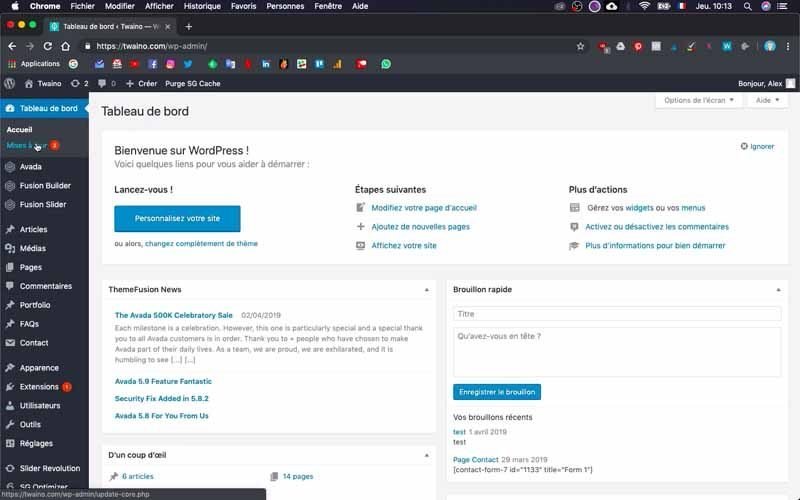
I click on the “Updates” menu and I have all the pending updates including the one for a plugin “SG Optimiser” and the one for my theme “Avada”. On the other hand, for the “Extension” menu, I have all the extensions with an update notification for the one that needs it.
3) Update your plugins
Go to the “Updates” menu and check the plugin you want to update.
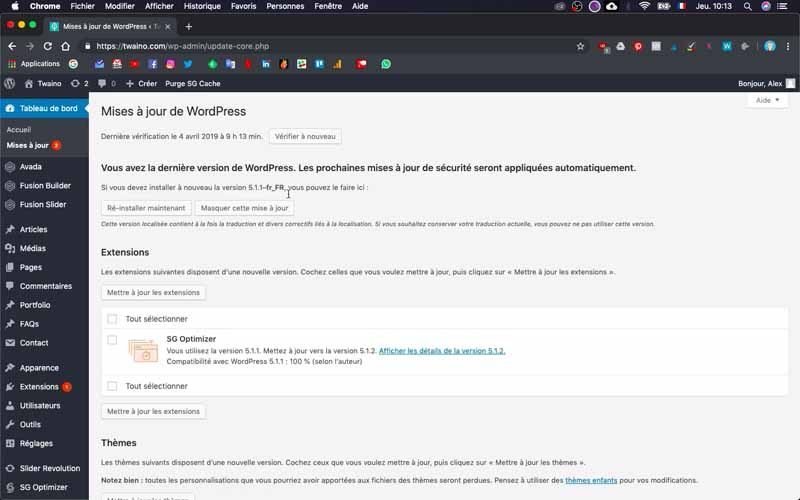
Note that you have the option to select all and update all if you have several to update. But again, I don’t recommend it, as a precaution.
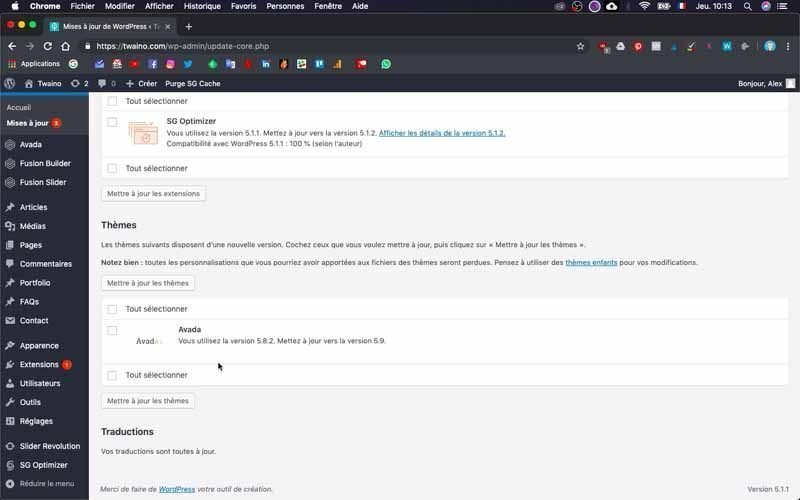
After making the selection, press the “Update Extensions” button that is right on top of the extensions to be updated. The process only takes a few seconds and on the page that comes up, you have a confirmation message. I got “SG Optimizer has been updated” followed by “Show details” for the curious.
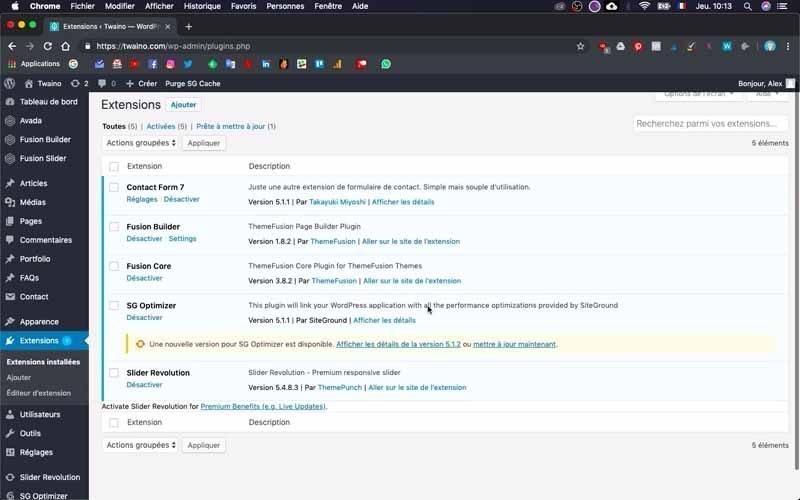
At the bottom of the page, you have two options. They are “Go back to the extensions page” or “Go back to WordPress updates”. Choose what suits you best. I choose the second one.
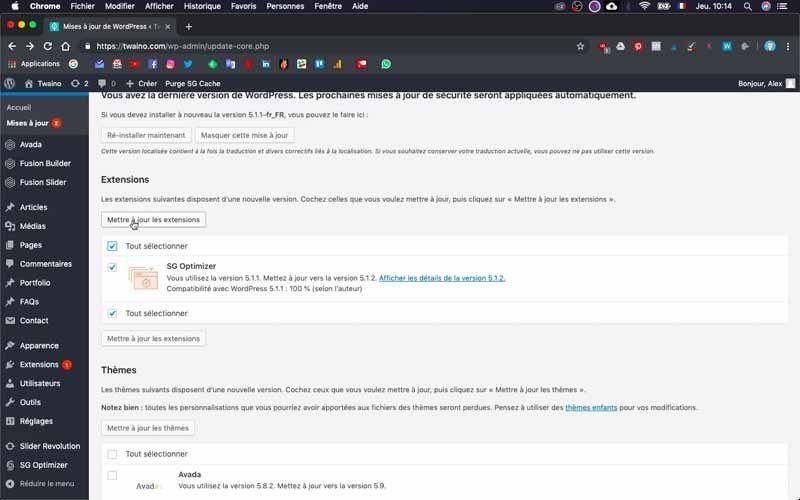
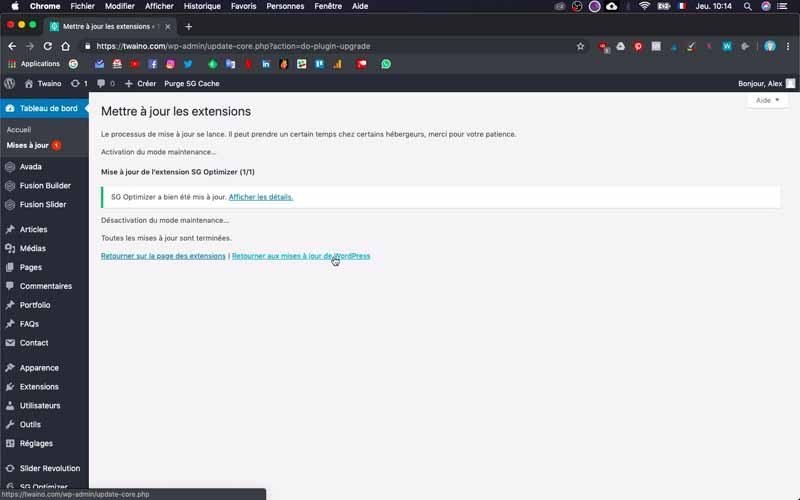
4) Update your WordPress theme
You will proceed in almost the same way as in the previous step to update your theme. So I’m doing the update for my theme and I just finished the two updates that were pending.
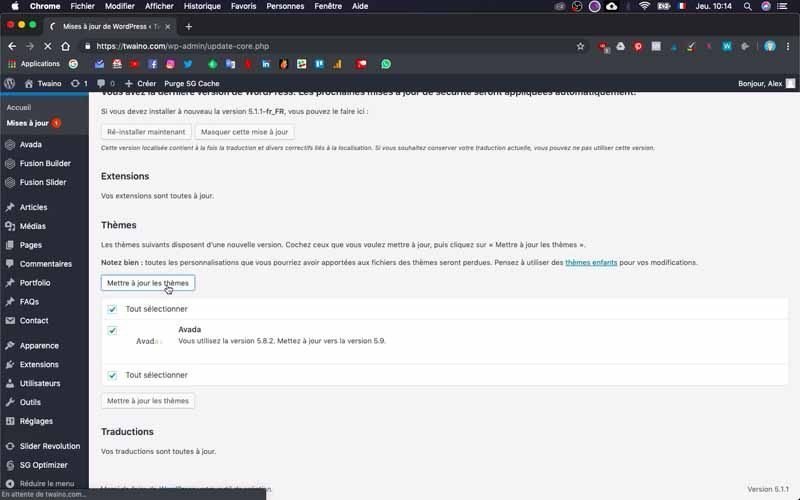
But sometimes this is not enough and other actions may be required. Indeed, upgrading some themes may sometimes require that you also upgrade some plugins that are directly related to it.
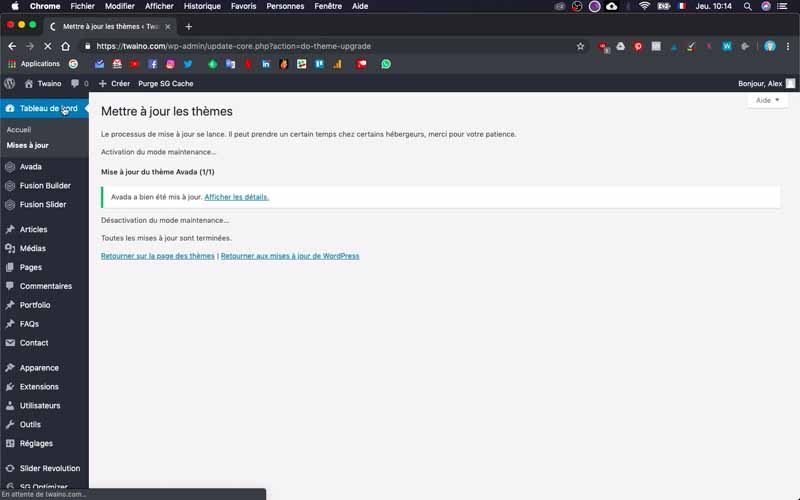
5) Complete the upgrade of your theme
For my “Avada” theme, I have notification of two additional updates to complete. You can go directly to the upgrade interface from the dashboard home or you can go through your theme menu.
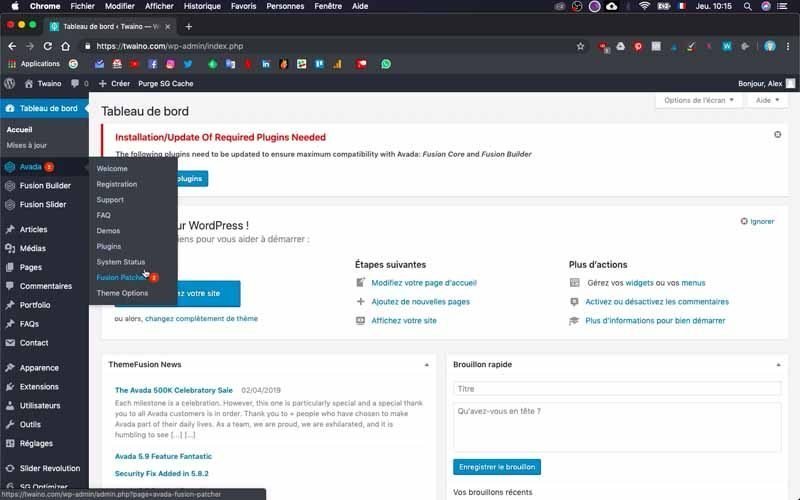
In my case, I click on “Avada” and in the options that appear, I select “Fusion Patcher” which by the way is followed by the number 2. On the next page, there are two patches that I have to apply and I click successively on the first blue button “Apply patch” and then on the second.
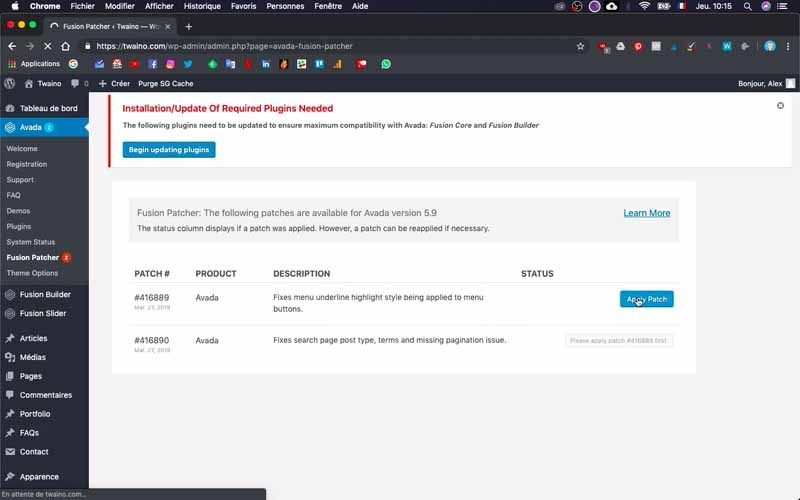
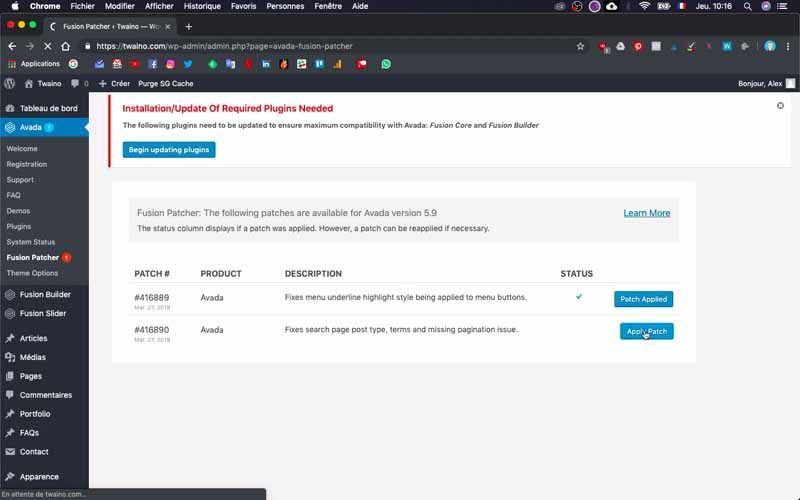
After applying the patches, I go to the blue button “Begin updating plugins” which is directly above.
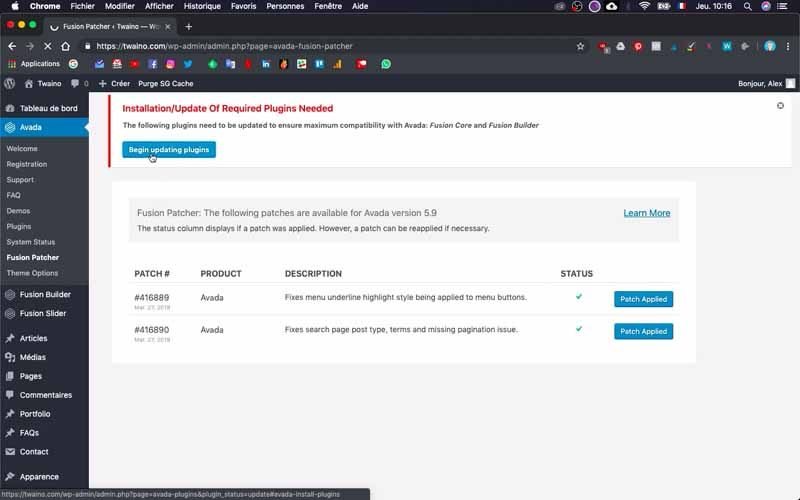
I have several plugins on the space that shows up, but what interests me here are the ones that are marked “Required”.
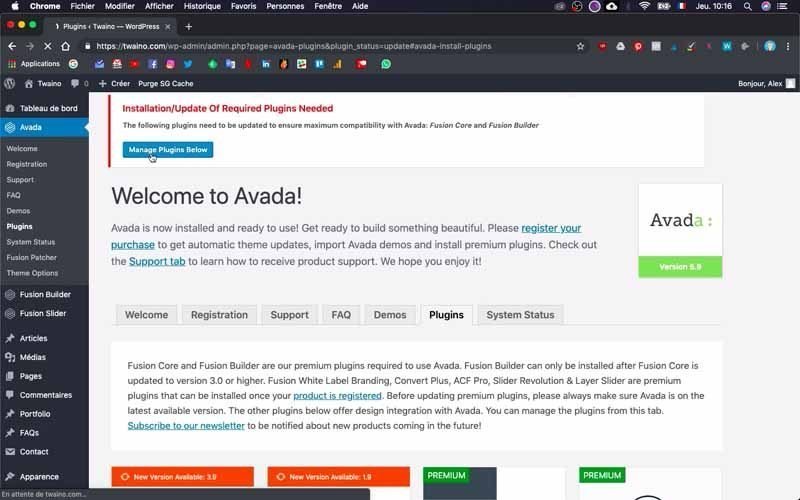
These are the ones that are required and I’m going to upgrade each of them by clicking on the blue “Update” button that appears when I hover over them.
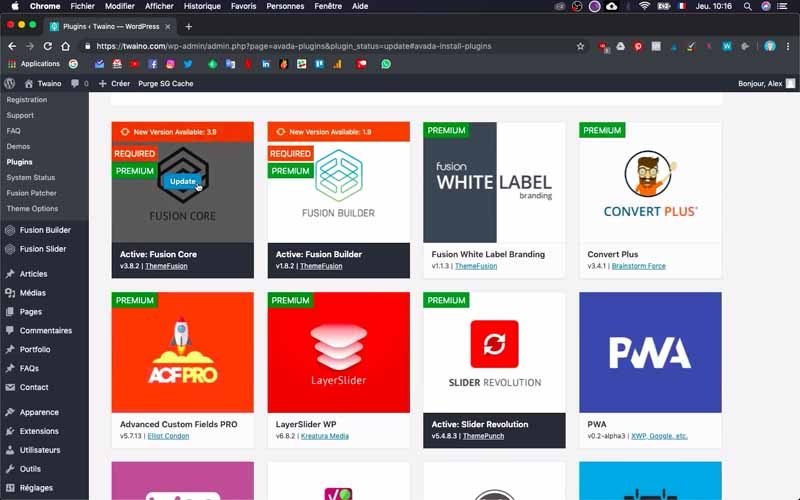
And that’s it! I just finished updating the plugins and the WordPress theme. So no notification shows up to indicate a pending update.
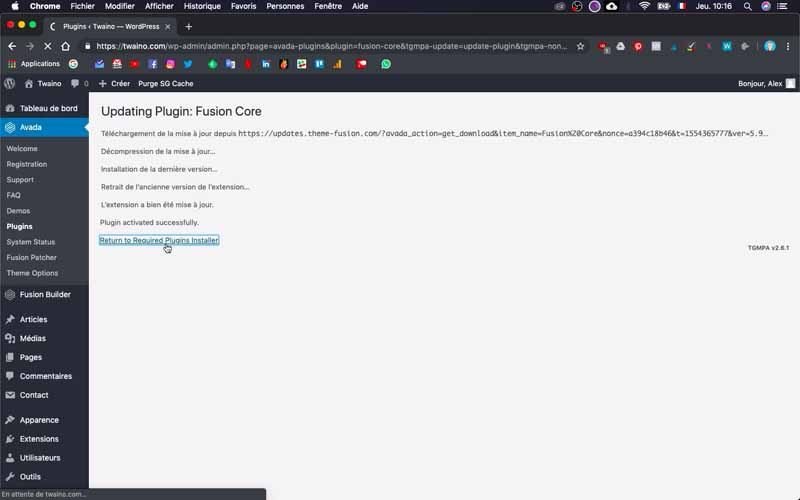
However, there is one last very important step.
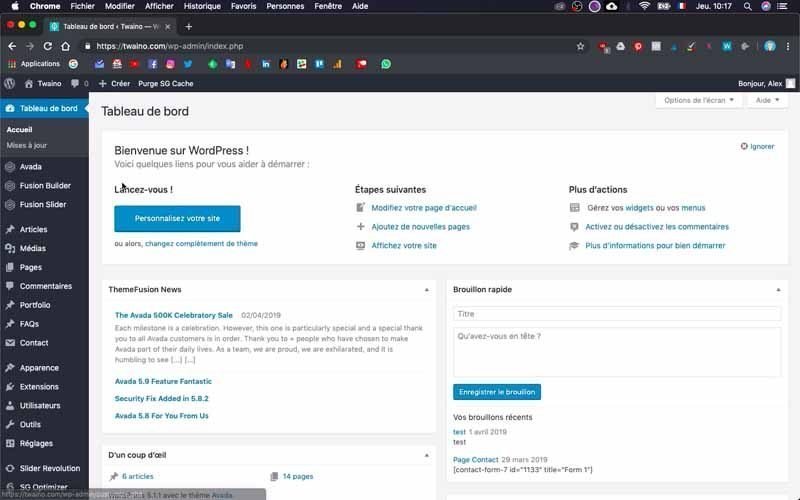
6) Check what your website looks like
I recommend that you always look at what your website looks like when you make updates. Feel free to browse through your pages and articles to make sure everything is correct and working well.

If it’s not, you can simply back up your site with your backup or call your web host.
Conclusion
Updating the components of a website is very important, whether it is for plugins, themes or the CMS itself. Thanks to this, you will be able to take advantage of new functionalities, correct some bugs that you may not notice and above all reinforce the security of your website. Most of the time, it is a very simple process, achievable in a few seconds and with a few clicks. However, sometimes you will face errors or troubles on your website and that’s why you need to follow good practices to avoid possible problems. The update of the WordPress CMS will be the subject of a future article.
See you soon then.


